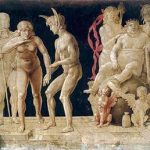
An exhibition not to be missed. Spectacular for the importance of the works – an anthology that is breathtaking of every major Italian drawings of the fifteenth century – and unique because it was based on two groups of the ancient richest world’s Italian drawings: the Cabinet of the Uffizi Florence and the British Museum in London.
One hundred sheets that take your breath away
After a stop in London greeted by an outstanding success, this anthology of one hundred sheets are able to take your breath away (with works by Angelico, Lippi, Pollaiuolo, Verrocchio, Botticelli, Perugino, Ghirlandaio, Leonardo, Raphael, Michelangelo, Pisanello , Mantegna, Bellini, Carpaccio and Titian, to name a few) arriving at the Uffizi in Florence and will remain here until June 12 (curators Hugo Chapman and Marzia Faietti; catalog Giunti).
What are the plans?
The exhibition offers not only the aesthetic ecstasy but also an opportunity to learn something. For example, what is the use designs. Abstract: no plan was ever devised for the use we make of it today, that is framed and hung on a wall. Michelangelo, who kept his papers discreetly hidden from view of strangers, would be horrified to see them on the walls of the Uffizi. So what are these sheets? They served primarily as warehouses for ideas, as valuable reserves of figurative motifs useful in the production of paintings, as well as a precious commodity to be transmitted to their children and students to shop. Typical in this sense, were the drawings of animals and birds of the Lombardy area handed down as a repertoire of motifs used in the paintings or manuscripts. With this use of shop drawings were pasted in many great books and lovingly collected over the centuries. And so it came down to us.
The drawings could also be made by artists as gifts to other artists or clients, or were linked to the portraits in the leaves, they are plucked from live faces and draperies, which then served to the composition of the painting into the shop. The exhibition shows that there were also drawings to be annexed to contracts of works of painting and architecture were used to show who signed which would have been more or less the final outcome. Often – especially among artists – drawings replacing the letters, people or landscapes were designed instead to be described in words (the pattern shown above into this category).
Then there were the drawings of the placement of art, that is related to apprenticeship in the workshop and the preparation of the finished works. The items (e.g. ancient statues) are included in this section. But artists do not draw only courtly subjects: in the exhibition we learn that their task was also to design – like modern designer – shields, jugs, cups, tapestries, embroideries, ephemeral architecture for court festivities and so on.
The preparation of the paintings, then, required a great advance in graphics. It took lots of drawings: preliminary sketches, studies and details together, finished drawings and their translation on the cartons. A lot of beautiful paper.
Source: http://www.ilsole24ore.com/art/cultura/2011-03-25/disegni-italiani-michelangelo-tiziano-175534.shtml?uuid=AatggVJD